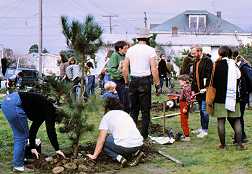
Bay Area Rapid Transit (BART), in the late 1960s, demolished 200 Berkeley homes to trench and submerge their rail system. BART then filled in tons of dirt on top of the tube it built and in this way “reclaimed” the land that it bulldozed.
It strip-mined Berkeley to submerge the trains and above left four blocks along Hearst Avenue a barren, ugly field of dust in summer and mud in winter. An eyesore. BART officials said that they didn’t have funds (or mental bandwidth?) to develop it, that is, monetize it.
Another eyesore appeared in Berkeley a year later. This time almost a square block of homes were razed by the corporation up the hill pretending to be a seat of wisdom and inquiry. The University of California had planned to build student housing, but ran out of funds, it said, and left a mud lot in its wake.
The south campus community believed that the university wanted to remove a dissident community of artists, lefties, and hippies that had lodged in the affordable housing on that site.
In 1969, a year after the demolition, a rag-tag bunch of malcontents occupied the mud lot and began planting trees and shrubs and named their new area People’s Park. University officials had no opportunity to negotiate, as the Republican mayor of Berkeley, Ed Meese, the District Attorney of Alameda County, and the Governor of California, Ronald Reagan went ballistic. How outrageous to imagine a forsaken lot transformed into a site of communality and pride by a bunch of dope fiends and commies!
Governor Reagan, just elected to office, saw the garden as a direct affront to his Law and Order campaign promise. The mayor of Berkeley needed no excuse to unleash his racist police force. On May 15, 1969, DA Meese likewise sent in Sheriff deputies to viciously attack the park defenders.
A police riot ensued. Deputies with buckshot-loaded rifles shot indiscriminately into the crowds. In the battle that lasted into the night, one bystander on a roof nearby was killed, another blinded and over 100 wounded.
Several days later, after martial law was declared and several thousand National Guardsmen entered the city, another bit of assaulted landscape, not two miles from People’s Park, beckoned the imaginations of the outraged residents. It was hardly surprising that they tried to build their vision of communalism on this abandoned land. It was in the air, once the tear gas cleared.
The Hearst Strip was occupied and provocatively proclaimed People’s Park Annex, though the annex was a larger piece of real estate than the University’s mud lot. Shovels, pick-axes and rakes appeared. Wheelbarrows and makeshift carts transformed the barrenness. Rubble became little walls encircling plantings. Saplings took positions and promised a forest.
But more than gardening took place. What was an ugly sliver of dirt became a commons for partying, music and potlucks. But not without overcoming, several times, the devastation caused by assaults of the guardians of law and order.
On one occasion late at night, young tree trunks were snapped and broken and plants trampled by the armed Midnight Raiders (the police). And at another time, in broad daylight, the cops trundled armfuls of plants into paddy wagons. They arrested the bushes and flowers!
After each attack the people came back and replanted. The neighbors near the park and their allies were galvanized for the long haul. And they partied some more. The park over time became a place to drop off stuff for reuse. Car seats became garden furniture. Steel tubing was transformed into playground swings, a large jungle gym and other imaginative, playful structures.
A stone and mortar water fountain was installed after a permit was obtained from the water utility and when a period of drought ensued and the utility cut off the water, a well was dug to irrigate the plants and trees.
After ten years of various haggles over use of the land, a supportive state legislator was elected, and using a cleverly worded proposal written by park neighbors, managed to pass a law that forced the sale of BART land to the city.
In honor of the First People, the park was officially recognized in 1979 as Ohlone Park, the first and only park created by citizen initiative in Berkeley. The park stands today as a successful land occupation. A rarity anywhere.
Bernard Marszalek, a Berkeley resident since the 1980s, is editor of The Right to be Lazy by Paul LaFargue (Kerr/ AK Press). His rants are at ztangi.org.
